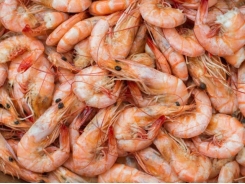Potential applications of bacteriophages for AHPND control

Isolated phages evaluated effective in controlling major farmed shrimp disease, inhibiting bacterial growth
Isolated phages tested are effective in controlling AHPND infection in farmed penaeid shrimp and inhibit bacterial growth. and inhibit bacterial growth. Photo by Darryl Jory.
Acute hepatopancreatic necrosis disease (AHPND) is caused by a Vibrio bacterium (V. parahaemolyticus) that has caused substantial mortalities – up to 100 percent – in affected, farmed penaeid shrimp in several countries.
This disease was first reported in China in 2009 and subsequent outbreaks occurred in Malaysia, Thailand, the Philippines, Mexico and various other Latin America countries, and in 2017 also in Bangladesh and the United States. Losses due to AHPND have been estimated to be more than $1 billion per year. Therefore, it is important to develop and effectively implement control measures to prevent catastrophic losses to the shrimp farming industry.
Bacteriophages, commonly called phages, are ubiquitous viruses that infect bacteria and can be used to control infectious diseases in humans, animals and plants. The name is based on the word bacteria and the Greek phagein, meaning “to devour.”
Phages can replicate within bacteria after their genome is injected into the bacteria. Phages have been proposed as an alternative method since they show an effective bacteriolytic activity and possess advantages over conventional antibiotics: phages are natural and are most common and diverse, and widely distributed in the environment, including seawater – and are also relatively inexpensive. Phages have been used for many years as an alternative to antibiotics in several countries, and are a possible treatment against multi-drug-resistant strains of many bacteria resistant against several drugs.
1/ Phage infectivity results
For bacteriophage pVp-1, its infectivity was tested in 22 strains AHPND-causing Vibrio parahaemolyticus (abbreviated as VpAHPND) strains. These bacterial isolates were obtained from pond water, sediment samples and the stomachs of shrimp affected by AHPND/EMS in Southeast Asia and Latin America countries. Pure cultures were obtained by streaking on 2 percent NaCl tryptic soy agar (TSA) plates. This phage was able to infect 91 percent (20 strains) of the VpAHPND tested and demonstrated strong bacteriolytic activity against 3 highly pathogenic strains (Fig. 1).



Fig. 1: Bacteriolytic activity of pVp-1 and its enlarged morphology against three representative AHPND/EMS V. parahaemolyticus strains: 13–028/A3 (a), Vietnam isolate; 13–511/A1 (b) and 13-306D/4 (c), Mexico isolates.
2/ Evaluating effectiveness
Furthermore, its effectiveness was evaluated in the laboratory challenge studies with SPF (specific pathogen free) juveniles of Pacific white shrimp (Penaeus vannamei). Test animals (n = 96, average weight = 1.02 g) were kept under appropriate conditions (water temperature 25 degrees-C; salinity 25 percent) and three tanks were designed for controls.
Tank 1 was designated as a negative control without bacterial challenge or phage treatment; tank 2 was designated as a phage control with phage treatment by bath immersion (1.5 x 106 PFU/ml) and feeding (1.5 x 108 PFU/shrimp) using pellets (5 percent of body weight) that had been impregnated with the phage suspension, but not bacterially challenged. And tank 3 was designated as a positive control with a bacterial challenge but not phage treated.
For the challenge test, shrimp were treated with at various time points (24, 6, and 1 hour prior to the bacterial challenge, and 1 hour after the bacterial challenge), and exposed to V. parahaemolyticus 13-028/A3 (5.0 x 105 CFU/ml) for 24 hours by immersion method. Each group was monitored for symptoms of infection and cumulative mortality was recorded daily for five days after the bacterial challenge.
From the results, shrimp treated with pVp-1 displayed significant protection, over 25 percent (maximum 50 percent mortality), whereas the positive control groups (not treated with phage pVp-1, only exposed to VpAHPND) showed a 100 percent mortality. Histopathological features of the hepatopancreas of shrimp were shown in Fig. 2.

Fig. 2: Histopathological features of the hepatopancreas of shrimp at 48 hours of phage treatment. The shrimp were challenged by AHPND-V. parahaemolyticus 13-028/A3 strain and treated with the phage pVp-1. Negative control (a) and phage control (b) showed the normal appearance of the hepatopancreas. Positive control (c), challenged but not treated, showed the acute sloughing of hepatopancreatic tubular epithelial cells. The phage-treated shrimp demonstrated the protected morphology of the hepatopancreas. Scale bars 30 µm
V. campbellii strains carrying pirABvp genes from diseased shrimp were recently identified as causative agents of AHPND, and we tested these strains for the second bacteriophage, pVp-2, isolated from Penaeus vannamei. The phage pVp-2 effectively lysed several Vibrio parahaemolyticus (VpAHPND)and also Vibrio campbellii (VcAHPND) and forming plaques in TSA+ plates (Fig. 3).

Fig. 3. Bacteriolytic activity of pVp-2 against representative AHPND/EMS V. campbellii strain.
3/ Perspectives
In our study, we demonstrated that the isolated phages evaluated are effective in controlling AHPND infection and inhibit bacterial growth when applied to the shrimp. Further studies are needed to evaluate the effectiveness of the bacteriophages against AHPND in laboratory and field trials.
Có thể bạn quan tâm
Phần mềm

Phối trộn thức ăn chăn nuôi

Pha dung dịch thủy canh

Định mức cho tôm ăn

Phối trộn phân bón NPK

Xác định tỷ lệ tôm sống

Chuyển đổi đơn vị phân bón

Xác định công suất sục khí

Chuyển đổi đơn vị tôm

Tính diện tích nhà kính

Tính thể tích ao hồ



 Demand feeding through automatic dispensing systems
Demand feeding through automatic dispensing systems  Prebiotic use in feed may boost shrimp survival
Prebiotic use in feed may boost shrimp survival